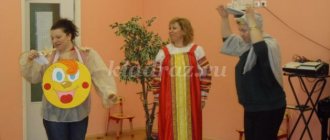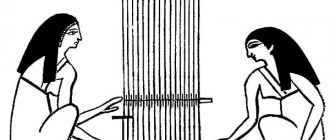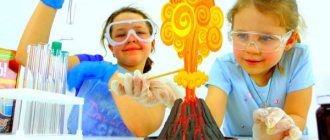An essential feature of theatrical activities for children of senior preschool age
In the pedagogical and psychological literature there are various names for theatrical activities: theatrical play activities, theatrical play creativity, theatrical games, theatrical performances, theatrical amateur performances, theatrical activities, etc.
All types of play are, in essence, the child’s art, his creativity. Theatrical play is a typical basis for artistic creativity. Therefore, theatrical play can be called creative play.
Some psychologists are of the opinion that theatrical games cannot be considered as a creative activity, since nothing new is created in them. Indeed, if we approach play with the same standards as adult activities, then the term “creativity” is inappropriate. But this is justified if you look at the problem from the point of view of child development. There is no reason to deny the possibility of creative self-expression of children in theatrical play, since theatrical activity contains creativity and is itself an artistic activity.
According to S.N. Tomchikova, theatrical activity of preschoolers is a specific type of artistic and creative activity, during which its participants master the available means of performing arts and, depending on the chosen role (actor, author, designer, viewer, etc.), participate in the preparation and conducting various types of theatrical performances, becoming familiar with theatrical culture.
Theatrical games are called so, apparently, because of their closeness to theatrical performance. The spectacle is always enjoyable, and the storytelling enhances the game's appeal.
By theatrical games, scholars mean “theatrical games” whose “plots are familiar fairy tales or theatrical performances based on ready-made scripts.”
Theatrical play activities are of great importance for the comprehensive education of children: they develop artistic taste, creative and declamatory abilities, a sense of collectivism is formed, and memory develops.
Feature of theatrical games: They have a ready-made plot, that is, the child’s activity is predetermined by the text of the work. Pedagogical preschool artistic aesthetics of children.
A real theatrical play is a rich field for children's creativity: The text of a work is simply a canvas into which children can weave new storylines, introduce additional roles, change the ending, etc.
It was noted that theatrical games differ from role-playing games not only in the plot, but also in the nature of the gaming activity. Theatrical games are playful performances that have a fixed content in the form of a literary work and are performed by children personally. In them, as in real theatrical art, specific images are created using such means of expression as intonation, facial expressions, gestures, posture and gait.
The pedagogical basis for organizing the process of theatrical activities in preschool educational institutions is the specificity of preschoolers’ perception of theatrical art. In order for this perception to be complete, it is necessary to introduce children to various types of theatrical activities. All theatrical games can be divided into two main groups: Directing games and dramatization games.
The first group - director's games in kindergarten - includes tabletop, shadow theater, and theater on a flannelgraph. Here the child or adult is not an actor, he or she creates the scene, plays the role of a toy character - three-dimensional or flat. He or she acts for him or her, portrays him or her using facial expressions, intonation, and gestures. The child's pantomime is limited. He or she acts with a stationary or sitting figure or toy. The emphasis here is on the language, its themes, intonation, expressiveness, and diction.
MAGAZINE Preschooler.RF
Features of organizing theatrical activities with preschool childrenCurrently, a great deal of theoretical and practical experience has been accumulated in organizing theatrical activities in kindergarten. The works of domestic teachers, scientists, methodologists are devoted to this: N. Karpinsky, A. Nikolaicheva, L. Furmina, L. Voroshnina, R. Sigutkina, I. Reutskaya, L. Bochkareva, I. Medvedeva, T. Shishova and others.
Theater activities should provide children with the opportunity not only to study and understand the world around them through comprehension of fairy tales, but to live in harmony with it, receive satisfaction from classes, a variety of activities, and successful completion of tasks. From this point of view, the organization and space of the theater room is of great importance.
The environment is one of the main means of developing a child’s personality, the source of his individual knowledge and social experience. Moreover, the subject-spatial environment should not only ensure joint theatrical activities of children, but also be the basis for the independent creativity of each child, a unique form of his self-education. Therefore, when designing a subject-spatial environment that provides theatrical activities for children, the following should be taken into account:
- individual socio-psychological characteristics of the child;
- features of his emotional and personal development;
- interests, inclinations, preferences and needs;
- curiosity, research interest and creativity;
- age and gender role characteristics.
The socio-psychological characteristics of preschool children suggest the child’s desire to participate in joint activities with peers and adults, as well as the need for privacy that arises from time to time. At the same time, to ensure an optimal balance of joint and independent theatrical activities of children, each age group should be equipped with a theater area or a fairy tale corner, as well as a “quiet corner” where the child can be alone and rehearse a role in front of a mirror or look at the illustrations again for a performance, etc.
In order to realize the individual interests, inclinations and needs of preschoolers, the subject-spatial environment should ensure the right and freedom of choice of each child for any activity or for the theatrical performance of a favorite work. Therefore, in the area of theatrical activity there should be different types of puppet theater (finger, bi-ba-bo, puppet), children's drawings, etc. In addition, it is necessary to periodically update material focused on the interests of different children.
The development of curiosity and research interest is based on the creation of a range of opportunities for modeling, searching and experimenting with various materials when preparing attributes, scenery and costumes for performances. To do this, in the area of theatrical activity it is necessary to have a variety of natural and waste materials, fabrics, and costumes for dressing up.
Taking into account the gender role characteristics of children, equipment and materials are placed in areas for theatrical activities that meet the interests of both boys and girls.
The content of theatrical classes includes:
- watching puppet shows and talking about them;
- dramatization games;
- acting out various fairy tales and dramatizations;
- exercises to develop expressiveness of performance (verbal and non-verbal);
- exercises for the social and emotional development of children.
Of course, the teacher plays a huge role in theatrical activities. The teacher himself needs to be able to read expressively, tell, look and see, listen and hear, be ready for any transformation, i.e. master the basics of acting and directing skills. One of the main conditions is the adult’s emotional attitude to everything that happens, sincerity and genuineness of feelings. The intonation of the teacher’s voice is a role model. Therefore, before offering children any task, you should practice yourself several times.
Methodological recommendations for organizing theater classes.
During classes you must:
- listen carefully to children’s answers and suggestions;
- if they do not answer, do not demand explanations, proceed to actions with the character;
- when introducing children to the heroes of works, set aside time so that they can act or talk with them;
- ask who did something similar and why, and not who did it better;
- Finally, in various ways to bring joy to children.
Basic requirements for organizing theatrical games in kindergarten:
- Content and variety of topics.
- The constant, daily inclusion of theatrical games in all forms of the pedagogical process, which makes them as necessary for children as role-playing games.
- Maximum activity of children at the stages of preparation and conduct of games.
- Cooperation of children with each other and with adults at all stages of organizing a theatrical game.
Theatrical activities in kindergarten can be organized in the morning and evening hours at unregulated times; is organically included in various other classes (musical, artistic, etc.), and is also specially planned in the weekly schedule of classes in the native language and familiarization with the outside world. It is desirable that all organized forms of theatrical activities be carried out in small subgroups, which will ensure an individual approach to each child. Moreover, each time subgroups should be formed differently, depending on the content of the classes.
In accordance with the inclinations and interests of children, the work of various studios can be organized in the evening ( "Puppet Theater for Kids" , "Theater Salon" , "Visiting a Fairy Tale" , etc.)
Duration of each lesson: 15 – 20 in the junior group, 20 – 25 minutes in the middle group and 25 – 30 minutes in the senior group. Individual work and general rehearsals are held once a week for no more than 40 minutes. It is advisable to conduct classes in a spacious, regularly ventilated room using soft, three-dimensional modules of various designs with the presence of a musical instrument and audio equipment. Lightweight clothing, preferably sports, soft shoes or slippers are required.
The first theatrical games are conducted by the teacher himself, involving the children in them. Further, the lessons use small exercises and games in which the teacher becomes a partner in the game and invites them to take the initiative in organizing it, and only in older groups can the teacher sometimes be a participant in the game and encourage children to be independent in choosing a plot and playing it out.
Particular attention in organizing theatrical activities is paid to the interaction of the preschool educational institution with the family. This work implements the following tasks:
- Maintain the child's interest in theatrical activities. Whenever possible, try to attend children's performances.
- Discuss with the child before the performance the features of the role that he will play, and after the performance - the result obtained. Celebrate achievements and identify ways for further improvement.
- Offer to perform the role you like at home, help act out your favorite fairy tales, poems, etc.
- Tell friends in the presence of the child about his achievements.
- Tell your child about your own impressions received as a result of watching plays, movies, etc.
- Gradually develop in the child an understanding of theatrical art, a specific “theatrical perception” based on communication between a “living artist” and a “living spectator” .
- Whenever possible, organize visits to theaters or viewings of video recordings of theatrical performances.
Thus, such an organization of theatrical activities contributes to the self-realization of each child and the mutual enrichment of everyone, since adults and children act here as equal partners of interaction. It is in the general performance that the child naturally and easily assimilates the rich experience of adults, adopting patterns of behavior. In addition, in such joint activities, educators get to know children better, their character traits, dreams and desires. A microclimate is created, which is based on respect for the personality of the little person, care for him, and trusting relationships between adults and children.
| Next > |
The influence of theatrical play on the development of a child’s general abilities
Play in the preschool period is the main activity of children and has a great influence on their mental development (L.S. Vygotsky, A.V. Zaporozhets, A.L. Leontyev, A.A. Lyublinskaya, D.B. Elkonin, etc. ) The term “game” summarizes various manifestations of children’s activities, which differ, first of all, in the nature of the actions and their focus - these are didactic, active, role-playing games, theatrical, musical and others. Thus, theatrical play, as one of the types of play activities, has a significant impact on the course of development of the child’s personality.
The value and peculiarity of theatrical art and its works lies in instant empathy, cognitive, emotional, communicative, vivid impact of the artistic image on the individual (A.V. Zaporozhets, A.A. Leontiev, A.N. Leontiev, Ya.Z. Neverovich) . Therefore, the role of theater in the aesthetic development of preschool children is invaluable, as evidenced by the research of A.M. Vinogradova, S.I. Merzlyakova. In the process of perceiving works of art, children develop a special type of cognition in the form of emotional images (L.I. Bozhovich, A.V. Zaporozhets). On the one hand, they reflect the external image of the surrounding world, on the other hand, the internal component in the form of sensations and ideas gives the emotional image a stimulating, activating character of reflection of the surrounding reality.
At a certain stage of mental development as a result of upbringing in preschool age, as noted by A.V. Zaporozhets, that side of aesthetic perception is revealed, which gives impetus to the development of its cognitive reality. This happens due to the fact that a work of art (visual, musical, literary) not only introduces the child to new phenomena and expands the range of his perception, but also allows him to understand his artistic image. In imaginary relationships, fairy tales, on the basis of which children’s habits and patterns of activity, aspirations and ideals, animal life and the natural world are usually formed.
The aesthetic perception of children, including the perception of theater, is not reduced to passive observation of certain aspects of reality. A preschool child has access to the internal activity of assistance, empathy, and the ability to mentally act in imaginary circumstances (L.S. Vygotsky, A.V. Zaporozhets, etc.). Older preschoolers are also able to understand the inner world of heroes and their contradictory nature. This makes it possible to use drama in the moral education of children, when various norms become significant for the child, correlating not only with a positive, but also with a negative, unattractive character (L.G. Lysyuk, S.G. Yakobson). Thanks to it, social feelings are formed, an emotional attitude to events and actions that are significant not only for the child personally, but also for those around him.
Drama is an extremely emotional activity, which makes it attractive to children. This brings great joy and surprise to the child. It contains the origins of creativity; children accept the guidance of an adult without realizing it. Theatrical activity most fully embraces the child’s personality and corresponds to the peculiarities of the development of his mental processes: Holism and simultaneity of perception, ease of imagination and faith in transformations, emotional sensitivity, not only figurative, but also logical thinking, motor activity, etc. (L.S. Vygotsky, D.B. Elkonin, etc.). This indicates the broad potential for the development of a dramatic play.





